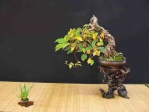Ume, Japanese Apricot
+12
John Quinn
moyogijohn
coh
Pavel Slovák
Randy_Davis
xuan le
Robert Steven
pjkatich
William N. Valavanis
drgonzo
Todd Ellis
Russell Coker
16 posters
Page 3 of 3
Page 3 of 3 •  1, 2, 3
1, 2, 3
 flowers beds on ume
flowers beds on ume
Hello, the big problem with japanese apricots ume is tha the tree produce a lot off flowers beds and a little off limlbs beds.
KIMURA SENSEI explain that , in pot, you have to graft branches with limlbs beds if you want that tree don't die.
In france, tha year , all prunus ume without freezing protection died with temperatures : 5°F for 15 days in february.
KIMURA SENSEI explain that , in pot, you have to graft branches with limlbs beds if you want that tree don't die.
In france, tha year , all prunus ume without freezing protection died with temperatures : 5°F for 15 days in february.

abcd- Member
 Re: Ume, Japanese Apricot
Re: Ume, Japanese Apricot
Sorry, my english is very bad :
the big problem with mume is that the tree produces many flower buds and little leaves buds ( not beds ) .
KIMURA SENSEI explain that , in pot, you have to graft branches with limlbs buds if you don't graft branches with leaves buds, the tree don't grow correctly.
the big problem with mume is that the tree produces many flower buds and little leaves buds ( not beds ) .
KIMURA SENSEI explain that , in pot, you have to graft branches with limlbs buds if you don't graft branches with leaves buds, the tree don't grow correctly.

abcd- Member
 Re: Ume, Japanese Apricot
Re: Ume, Japanese Apricot
Thanks for the explanation, and no problem. There are times when I hardly understand what I'm saying myself.
fredtruck- Member
 Re: Ume, Japanese Apricot
Re: Ume, Japanese Apricot
Prunus species in the United States are available as cutting-grown material from a few sources - Camellia Forest is one on the East Coast. Evergreen Gardenworks on the West Coast. They both have many varieties and ship all over. The material is usually 1/4" to 1/2" in diameter. It is very common to see grafted Prunus sp. and sometimes you can find one where the graft is not bad - but I usually avoid the grafted material. My understanding is that in Japan they will graft a specific species - with a certain colored flower onto another prunus mume - in order to get that colored flower. Prunus species grow very fast and will have many leaves - by the late fall and early winter - the leaf buds for next year will differentiate from the flower bud - very easy to see. If the tree does not get flower buds - well then something has happened, ie. too young, too much pruning, heat stress, leaves dropped etc. There are many factors involved.......Tom
tom tynan- Member
 Re: Ume, Japanese Apricot
Re: Ume, Japanese Apricot
Peter Tea has an article called "Flowering Plum Basics" in which he describes the Japanese practice for working with ume. Here's a pertinent quote:
In Japan, most Flowering Plums are grafted early on in life. Since people want the flowers, they would take a branch that is know to flower from another tree and graft it to a young root stock. This way, the tree will immediately start blooming. Unlike other flowering trees that may take 1-15 years before they bloom, Flowering Plum is much more unpredictable. So far, it seems that a tree will start to bloom somewhere between 20 year and 100+ years! I know this to be true because we have a Flowering plum that was grown from seed in the yard that is over 100 years old and one of the lower branches still won’t bloom. This unpredictability is the reason why people tend to graft instead.
--Peter Tea
For me, this article answered the grafting issue with ume pretty well.
In Japan, most Flowering Plums are grafted early on in life. Since people want the flowers, they would take a branch that is know to flower from another tree and graft it to a young root stock. This way, the tree will immediately start blooming. Unlike other flowering trees that may take 1-15 years before they bloom, Flowering Plum is much more unpredictable. So far, it seems that a tree will start to bloom somewhere between 20 year and 100+ years! I know this to be true because we have a Flowering plum that was grown from seed in the yard that is over 100 years old and one of the lower branches still won’t bloom. This unpredictability is the reason why people tend to graft instead.
--Peter Tea
For me, this article answered the grafting issue with ume pretty well.
fredtruck- Member
Page 3 of 3 •  1, 2, 3
1, 2, 3
 Similar topics
Similar topics» 2 days after Christmas and . . .
» Contorted Japanese Flowering Apricot
» Fungicide soak for Japanese flowering apricot? (Or for any prunus?)
» USA source for hard-to-find Japanese flowering apricot cultivars?
» Flowering apricot photos from last March - (It won't be long now!)
» Contorted Japanese Flowering Apricot
» Fungicide soak for Japanese flowering apricot? (Or for any prunus?)
» USA source for hard-to-find Japanese flowering apricot cultivars?
» Flowering apricot photos from last March - (It won't be long now!)
Page 3 of 3
Permissions in this forum:
You cannot reply to topics in this forum






